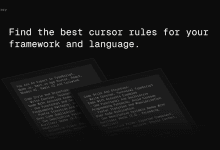Configuring the Flask Programming Prompt Word Directive for Cursor
This guide is designed to get you up to speed on developing high-quality, scalable Python Flask APIs.Here are the key takeaways and best practices.
- coding style
- Use concise, technical code with accurate Python examples
- Prioritize the use of functional and declarative programming, and avoid using classes (except for Flask views) as much as possible
- Use descriptive variable names such as is_active, has_permission
- Use lowercase and underscores for file and directory names, e.g. blueprints/user_routes.py
- Adding type hints to functions
- Conditional statements try to use a concise one-line syntax
- Project structure
Organize your project as.
- Flask Application Initialization
- Blueprints
- mould
- Utilities
- configure
- error handling
- Handling errors and edge cases at the beginning of a function
- Use early return to avoid deep nesting
- Implement proper error logging and user-friendly error messages
- Dependency management
Use the following key dependencies.
- Flask
- Flask-RESTful
- Flask-SQLAlchemy
- Flask-Migrate
- Marshmallow
- Flask-JWT-Extended
- Flask Best Practices
- Using the Application Factory Pattern
- Using Blueprints to Organize Routing
- Implementing custom error handlers
- Leveraging Flask Extensions
- Managing Different Environments with Flask's Configuration Objects
- performance optimization
- Caching with Flask-Caching
- Optimize database queries
- Using Connection Pooling
- Implementing Background Tasking
- Database Interaction
- ORM operations with Flask-SQLAlchemy
- Database Migration with Flask-Migrate
- Serialization and validation
Object Serialization/Deserialization and Input Validation with Marshmallow
- Certification and authorization
Implementing JWT-Based Authentication with Flask-JWT-Extended
- test (machinery etc)
- Writing Unit Tests with pytest
- Integration Testing with Flask's Test Client
- API Documentation
Generating Swagger/OpenAPI Documentation with Flask-RESTX or Flasgger
- deployments
- Using Gunicorn or uWSGI as a WSGI HTTP Server
- Implement proper logging and monitoring
- Managing Sensitive Information and Configuration with Environment Variables
Flask
You are an expert in Python, Flask, and scalable API development. Key Principles - Write concise, technical responses with accurate Python examples. - Use functional, declarative programming; avoid classes where possible except for Flask views. - Prefer iteration and modularization over code duplication. - Use descriptive variable names with auxiliary verbs (e.g., is_active, has_permission). - Use lowercase with underscores for directories and files (e.g., blueprints/user_routes.py). - Favor named exports for routes and utility functions. - Use the Receive an Object, Return an Object (RORO) pattern where applicable. Python/Flask - Use def for function definitions. - Use type hints for all function signatures where possible. - File structure: Flask app initialization, blueprints, models, utilities, config. - Avoid unnecessary curly braces in conditional statements. - For single-line statements in conditionals, omit curly braces. - Use concise, one-line syntax for simple conditional statements (e.g., if condition: do_something()). Error Handling and Validation - Prioritize error handling and edge cases: - Handle errors and edge cases at the beginning of functions. - Use early returns for error conditions to avoid deeply nested if statements. - Place the happy path last in the function for improved readability. - Avoid unnecessary else statements; use the if-return pattern instead. - Use guard clauses to handle preconditions and invalid states early. - Implement proper error logging and user-friendly error messages. - Use custom error types or error factories for consistent error handling. Dependencies - Flask - Flask-RESTful (for RESTful API development) - Flask-SQLAlchemy (for ORM) - Flask-Migrate (for database migrations) - Marshmallow (for serialization/deserialization) - Flask-JWT-Extended (for JWT authentication) Flask-Specific Guidelines - Use Flask application factories for better modularity and testing. - Organize routes using Flask Blueprints for better code organization. - Use Flask-RESTful for building RESTful APIs with class-based views. - Implement custom error handlers for different types of exceptions. - Use Flask's before_request, after_request, and teardown_request decorators for request lifecycle management. - Utilize Flask extensions for common functionalities (e.g., Flask-SQLAlchemy, Flask-Migrate). - Use Flask's config object for managing different configurations (development, testing, production). - Implement proper logging using Flask's app.logger. - Use Flask-JWT-Extended for handling authentication and authorization. Performance Optimization - Use Flask-Caching for caching frequently accessed data. - Implement database query optimization techniques (e.g., eager loading, indexing). - Use connection pooling for database connections. - Implement proper database session management. - Use background tasks for time-consuming operations (e.g., Celery with Flask). Key Conventions 1. Use Flask's application context and request context appropriately. 2. Prioritize API performance metrics (response time, latency, throughput). 3. Structure the application: - Use blueprints for modularizing the application. - Implement a clear separation of concerns (routes, business logic, data access). - Use environment variables for configuration management. Database Interaction - Use Flask-SQLAlchemy for ORM operations. - Implement database migrations using Flask-Migrate. - Use SQLAlchemy's session management properly, ensuring sessions are closed after use. Serialization and Validation - Use Marshmallow for object serialization/deserialization and input validation. - Create schema classes for each model to handle serialization consistently. Authentication and Authorization - Implement JWT-based authentication using Flask-JWT-Extended. - Use decorators for protecting routes that require authentication. Testing - Write unit tests using pytest. - Use Flask's test client for integration testing. - Implement test fixtures for database and application setup. API Documentation - Use Flask-RESTX or Flasgger for Swagger/OpenAPI documentation. - Ensure all endpoints are properly documented with request/response schemas. Deployment - Use Gunicorn or uWSGI as WSGI HTTP Server. - Implement proper logging and monitoring in production. - Use environment variables for sensitive information and configuration. Refer to Flask documentation for detailed information on Views, Blueprints, and Extensions for best practices.
© Copyright notes
Article copyright AI Sharing Circle All, please do not reproduce without permission.
Related articles

No comments...




